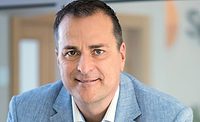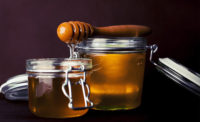Engineering R&D
Surgical knife turned food fraud investigator
With a little ingenuity, mass spectrometry technology has been teamed up with a surgical knife and proprietary software to find fraudulent food and/or beverages.



The handheld sampling device works as an input device to Waters Quadrupole Time of Flight (QToF) mass spectrometers. Source: Waters Corporation.



Sometimes, ingenious devices come about when seemingly disparate technologies are combined to create a new technology or instrument. Take, for example, the mass spectrometer—not a new technology, but capable of measuring all the chemical constituents of a material, though usually not without a lot of sample preparation.
The technology referred to as rapid evaporative ionization mass spectrometry (REIMS™) was developed by Zoltán Takáts, professor of analytical chemistry at Imperial College London and co-founder of Medimass Ltd. REIMS technology uses an electrosurgical handpiece to generate an aerosol that is transferred to a mass spectrometer for ionization and analysis.
In 2014, Waters Corporation a Massachusetts-based developer and manufacturer of mass spectrometers, acquired the REIMS technology from Medimass Ltd. Thereafter, Waters began to explore the development of a highly effective direct analysis system for scientists researching food fraud, adulteration and microbiology.
About a year ago, Professor Christopher Elliott, Institute for Global Food Security (Queens University Belfast) contacted Prof. Takáts to understand how REIMS technology might be applied to food applications, especially in detecting food fraud situations. Elliott specializes in methods of detecting toxic chemicals, such as mycotoxins, phycotoxins and plant toxins, in foods and agricultural commodities. He also led the UK government’s independent review of food systems following the 2013 horsemeat scandal.
The Waters REIMS research team has been diligently working to develop a technology for food fraud and safety applications that can be housed in a single box. To get a handle on this technology, we caught up with Dr. Mike Wilson (senior product manager) and Dr. Sara Stead (senior strategic collaborations manager - food and environmental) from Waters, who are involved with the project.
FE: What is the current status of the project?
Mike Wilson: The REIMS™ research system is commercially available for non-clinical applications. Right now, the system is mostly being used in exploratory research settings. Since Waters acquired the REIMS technology from Medimass Ltd. in July 2014, we’ve been working on the technology—both the hardware and software—to be used by the food science and health sciences communities and beyond. In particular, we’ve begun to explore the potential of REIMS to bring ambient ionization sampling into food science in collaboration with Queen’s University Belfast Professor Chris Elliot, who initially reached out to Imperial College London about potentially using the technique for food analysis. Waters is working with both Queen’s University and Imperial College to develop applications for the food science and health sciences fields.
FE: Are there any functioning systems in test or in use?
Sara Stead: Professor Elliott is using a REIMS research system to investigate its potential for use in uncovering food fraud, where organoleptic identification may be difficult, e.g., processed foods. Fish fraud is believed to be one of the most widely perpetrated food frauds in the world. Estimates of the amount of fraudulent practices range from 25 to 75 percent, depending on the geographic region and the species of fish involved. Species substitution is the most common type of fraud.
We’re also working with Elliott to explore the use of REIMS technology to identify a broader range of differences between samples beyond simple species differentiation. For example, we are investigating the possibilities of distinguishing between capture methods [line vs. trawl caught] and farmed vs. wild fish of the same species. These are extremely difficult variants to determine, even using today’s state-of-the-art methods, but we believe there is potential for such differences to be distinguished using this new tool.
FE: What are the major components of the system?
Wilson: The Waters REIMS research system with iKnife™ sampling combines direct-from-sample ionization with highperformance, time-of-flight mass spectrometry and powerful, intuitive analytics. REIMS technology causes direct, rapid heating of the sample, leading to the formation of vapor that is rich in sample-specific chemical information. The vapor is taken directly into the mass spectrometer where the molecules are ionized and then analyzed by high-resolution mass spectrometry [HRMS], which accurately measures the massto-charge ratio of the components of the vapor. Processing the HRMS data using multivariate statistics allows researchers to quickly and easily differentiate samples from one another and identify the differentiating features, allowing greater insight into the chemical and biological systems under investigation.
FE: Can you explain the main purpose of the iKnife sampling device?
Wilson: The iKnife sampling technology is what sets the system apart from traditional liquid chromatography mass spectrometry [LC-MS] and molecular techniques that are commonly used for these types of applications. Because the iKnife sampling device is connected to the mass spectrometer via a long, flexible tube, the user can bring the analysis to the sample rather than the sample to the analysis. It works by cutting into a sample using a high-frequency electric current applied to the tip of the knife. The heat generated during this cutting process produces a vapor that is transported along the tubing and into the mass spectrometer for analysis as I just described. Since the method is applied to intact samples, upfront sample preparation and chromatography are not necessary, significantly reducing time to result and providing lab managers more flexibility in testing.
FE: Once the analyzer has received the sample and analyzed it, what is its output data format?
Wilson: The primary raw data format is in the form of a mass spectrum, which allows us to determine the mass and relative abundance of the molecules from the sample. But, users don’t need to interpret the data themselves, because it’s automatically imported into a powerful but easy-to-use post-processing software package that uses multivariate analysis to determine statistical similarities and differences between samples. It can produce a variety of easy-to-understand graphical outputs showing which samples are similar to or different from each other and why. It can also interrogate online databases to help identify the individual molecules responsible for the similarities or differences.
FE: What food fraud/safety applications do you believe are suited to this technology?
Stead: We think REIMS technology has huge potential within the food industry, and in collaboration with Professor Elliott and his team, we are looking at a variety of different substances and applications. By identifying the patterns of selective chemical markers in foodstuffs, it is possible to determine the quality of the product, whether it is genuine and/or meets the label claims. We are currently developing applications for species substitution such as whether horsemeat has been mixed with beef or whether pig tissue is present in food products labeled as Halal. Other application areas include the botanical origin of honey such as the authenticity of manuka and kanuka honeys, profiling of the nutritional content of foods, profiling of resistance markers in cereal crops and rapidly identifying gross contaminant of foodstuffs.
FE: When will this technology become commonly available, and what form will it take?
Wilson: We are continuously working toward making our products accessible to a wider range of people outside the traditional MS user base, whether this accessibility means smaller and more transportable, easier to operate, faster time to result or more cost effective to own and use. REIMS technology is a great example of an innovation that, when combined with the right mass spectrometry and informatics solutions, will help us achieve this goal. We believe REIMS technology has potential for a huge impact across the food and drink industry over the next few years, and we’re sure that so far, we’ve only touched the tip of the iceberg in terms of its potential uses. Waters is committed to exploring the viability of REIMS technology in accordance with all applicable regulatory requirements. However, to date, no regulatory approvals have been sought for this technology.
FE: Are you looking for any food processors as collaborators, and if so, whom should they contact?
Stead: We are very interested in working with the food manufacturing sector to better understand their challenges and work with them to develop solutions based on this innovative technology. Anyone interested in discussing the technology further should contact me at sara_stead@waters.com.
Looking for a reprint of this article?
From high-res PDFs to custom plaques, order your copy today!












